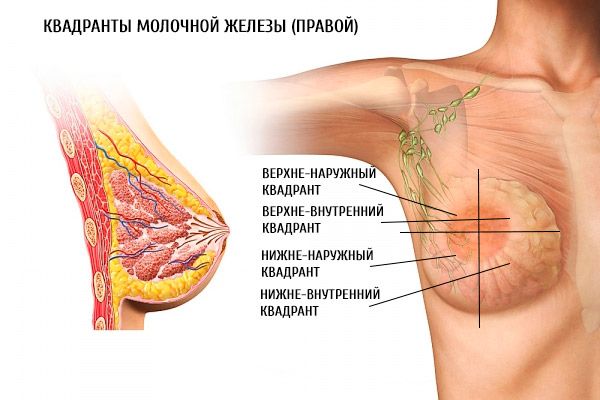Medical expert of the article
New publications
Breast quadrants
Last reviewed: 04.07.2025

All iLive content is medically reviewed or fact checked to ensure as much factual accuracy as possible.
We have strict sourcing guidelines and only link to reputable media sites, academic research institutions and, whenever possible, medically peer reviewed studies. Note that the numbers in parentheses ([1], [2], etc.) are clickable links to these studies.
If you feel that any of our content is inaccurate, out-of-date, or otherwise questionable, please select it and press Ctrl + Enter.
As is known, the human body consists of different body parts. Some of them are described in medicine as quadrants. This method of dividing a part of the body into four zones is used to clarify and specify the painful area or localize the pathological focus. The quadrants of the mammary gland are also divided in a similar way - this allows the doctor to accurately indicate in the diagnosis in which part of the breast the pathology is present.
How to determine the quadrants of the mammary gland?
- We stand in front of the mirror, lower our arms along the body - this way the chest takes on a natural shape.
- We mentally take the areola (the dark area around the nipple) as the center of intersection of the imaginary vertical lines.
- Draw a horizontal line from approximately the center of the armpit through the areola to the middle of the sternum (the sternum is the bony base that connects the ribs of the right and left halves of the chest in front).
- Draw a vertical line starting from the lower edge of the collarbone through the areola to the lower contour of the chest.
Thus, each mammary gland is conditionally divided into four parts:
- two upper parts (quadrants);
- two lower parts.
Those quadrants that are located closer to the sternum are called internal, and those that are located on the armpit side are called external.
Features of the quadrants of the mammary gland
The mammary glands can be classified by structure as tubular-alveolar glandular organs. They are localized in the anterior part of the chest within the 3rd to 7th rib.

The function of the glands is provided by the hormones estrogen. The anatomy is represented by the secretory department, a large number of alveolar canals, fatty and parenchymatous tissues.
The gland is divided into sections (segments), and a segment is divided into separate lobes with multiple alveoli.
The conditional division into quadrants – upper-outer, upper-inner, lower-outer and lower-inner – is very convenient for determining the location of the pathological focus.
Tumor processes, which include breast carcinoma, most often begin their development in the upper outer quadrant (in 45% of cases). Relatively rarely, diseases of the gland are found in the upper inner quadrant (up to 15%), in the lower outer quadrant (up to 10%), and in the lower inner quadrant (up to 5%). The central area (in the areola) accounts for about 25% of cases of diseases.
- Fibroadenomatosis, cystic mastopathy and malignant neoplasms most often affect the upper outer quadrant of the mammary gland. This is because the upper quadrant of the mammary gland has a greater thickness of the glandular layer relative to other areas of the breast. In this area, there are a large number of lymphatic and blood vessels that feed the inflammatory or tumor process.
- The outer quadrants of the breast are more likely than other areas to be injured, which can cause damage to the glandular tissue and the development of a precancerous condition.
- The lower outer quadrant of the mammary gland, like the upper one, has a well-developed capillary lymphatic network, which is located in the skin and premammary tissue. However, the existing lymphatic plexus in the areola area often "takes the hit" when the pathological process develops. For this reason, the lower quadrant of the mammary gland is least often subject to diseases, both inflammatory and malignant etiology.

In addition, the division of glands into quadrants is successfully used to assess the prevalence of the pathological process and the size of the lesion.
- If the disease affects any one quadrant, then it is appropriate to speak of a limited process.
- If the disease has spread to two or three quadrants of the mammary gland, then it is called a diffuse process.
- If the disease affects all four quadrants, then we are talking about total damage to the mammary gland.
The division of the mammary gland into quadrants is often used when drawing up a scheme for performing an operation, when making a diagnosis, when examining and self-examining the mammary glands. By naming a specific quadrant, the doctor always understands which area of the organ is being discussed.


 [
[